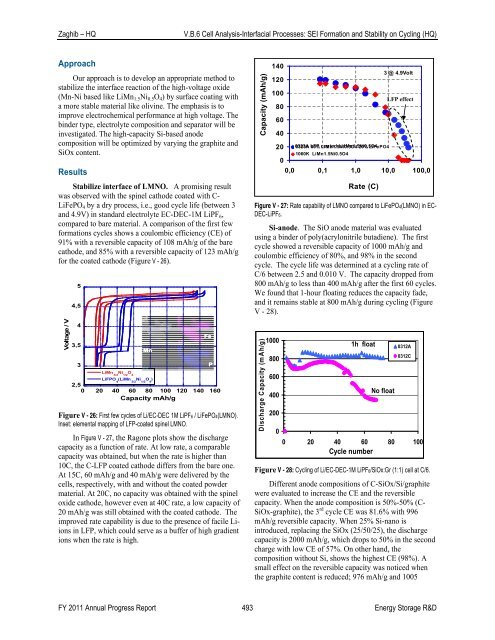V. Focused Fundamental Research - EERE - U.S. Department of ...
V. Focused Fundamental Research - EERE - U.S. Department of ...
V. Focused Fundamental Research - EERE - U.S. Department of ...
Create successful ePaper yourself
Turn your PDF publications into a flip-book with our unique Google optimized e-Paper software.
Zaghib – HQ<br />
V.B.6 Cell Analysis-Interfacial Processes: SEI Formation and Stability on Cycling (HQ)<br />
Approach 140<br />
5<br />
4<br />
3 @ 4.9Volt<br />
Our approach is to develop an appropriate method to 120<br />
stabilize the interface reaction <strong>of</strong> the high-voltage oxide<br />
100<br />
(Mn-Ni based like LiMn 1.5 Ni 0.5 O 4 ) by surface coating with<br />
LFP effect<br />
a more stable material like olivine. The emphasis is to<br />
80<br />
improve electrochemical performance at high voltage. The<br />
binder type, electrolyte composition and separator will be<br />
60<br />
investigated. The high-capacity Si-based anode<br />
40<br />
composition will be optimized by varying the graphite and<br />
20 0323A LFP 80% LiMn1.5Ni0.5O4 coated Li1Mn1,5Ni0,5O4 20% LiFePO4<br />
SiOx content.<br />
1060K LiMn1.5Ni0.5O4<br />
0<br />
Results<br />
0,0 0,1 1,0 10,0 100,0<br />
Stabilize interface <strong>of</strong> LMNO. A promising result<br />
was observed with the spinel cathode coated with C<br />
LiFePO 4 by a dry process, i.e., good cycle life (between 3<br />
and 4.9V) in standard electrolyte EC-DEC-1M LiPF 6 ,<br />
compared to bare material. A comparison <strong>of</strong> the first few<br />
formations cycles shows a coulombic efficiency (CE) <strong>of</strong><br />
91% with a reversible capacity <strong>of</strong> 108 mAh/g <strong>of</strong> the bare<br />
cathode, and 85% with a reversible capacity <strong>of</strong> 123 mAh/g<br />
for the coated cathode (Figure V - 26).<br />
Voltage / V<br />
4,5<br />
Capacity (mAh/g)<br />
Rate (C)<br />
Figure V - 27: Rate capability <strong>of</strong> LMNO compared to LiFePO4(LMNO) in EC<br />
DEC-LiPF6.<br />
Si-anode. The SiO anode material was evaluated<br />
using a binder <strong>of</strong> poly(acrylonitrile butadiene). The first<br />
cycle showed a reversible capacity <strong>of</strong> 1000 mAh/g and<br />
coulombic efficiency <strong>of</strong> 80%, and 98% in the second<br />
cycle. The cycle life was determined at a cycling rate <strong>of</strong><br />
C/6 between 2.5 and 0.010 V. The capacity dropped from<br />
800 mAh/g to less than 400 mAh/g after the first 60 cycles.<br />
We found that 1-hour floating reduces the capacity fade,<br />
and it remains stable at 800 mAh/g during cycling (Figure<br />
V - 28).<br />
Fe<br />
3,5 1h float<br />
Mn<br />
0312A<br />
800<br />
0312C<br />
3<br />
P<br />
LiMn Ni O<br />
3/2 1/2 4<br />
LiFPO (LiMn Ni O )<br />
4 4<br />
3/2 1/2<br />
2,5<br />
0 20 40 60 80 100 120 140 160<br />
Capacity mAh/g<br />
Figure V - 26: First few cycles <strong>of</strong> Li/EC-DEC 1M LiPF6 / LiFePO4(LMNO).<br />
Inset: elemental mapping <strong>of</strong> LFP-coated spinel LMNO.<br />
In Figure V - 27, the Ragone plots show the discharge<br />
capacity as a function <strong>of</strong> rate. At low rate, a comparable<br />
capacity was obtained, but when the rate is higher than<br />
10C, the C-LFP coated cathode differs from the bare one.<br />
At 15C, 60 mAh/g and 40 mAh/g were delivered by the<br />
cells, respectively, with and without the coated powder<br />
material. At 20C, no capacity was obtained with the spinel<br />
oxide cathode, however even at 40C rate, a low capacity <strong>of</strong><br />
20 mAh/g was still obtained with the coated cathode. The<br />
improved rate capability is due to the presence <strong>of</strong> facile Liions<br />
in LFP, which could serve as a buffer <strong>of</strong> high gradient<br />
ions when the rate is high.<br />
(mAh/g1000<br />
Discharge Capacity )<br />
600<br />
400<br />
200<br />
No float<br />
0<br />
0 20 40 60 80 100<br />
Cycle number<br />
Figure V - 28: Cycling <strong>of</strong> Li/EC-DEC-1M LiPF6/SiOx:Gr (1:1) cell at C/6.<br />
Different anode compositions <strong>of</strong> C-SiOx/Si/graphite<br />
were evaluated to increase the CE and the reversible<br />
capacity. When the anode composition is 50%-50% (C<br />
SiOx-graphite), the 3 rd cycle CE was 81.6% with 996<br />
mAh/g reversible capacity. When 25% Si-nano is<br />
introduced, replacing the SiOx (25/50/25), the discharge<br />
capacity is 2000 mAh/g, which drops to 50% in the second<br />
charge with low CE <strong>of</strong> 57%. On other hand, the<br />
composition without Si, shows the highest CE (98%). A<br />
small effect on the reversible capacity was noticed when<br />
the graphite content is reduced; 976 mAh/g and 1005<br />
FY 2011 Annual Progress Report 493 Energy Storage R&D



